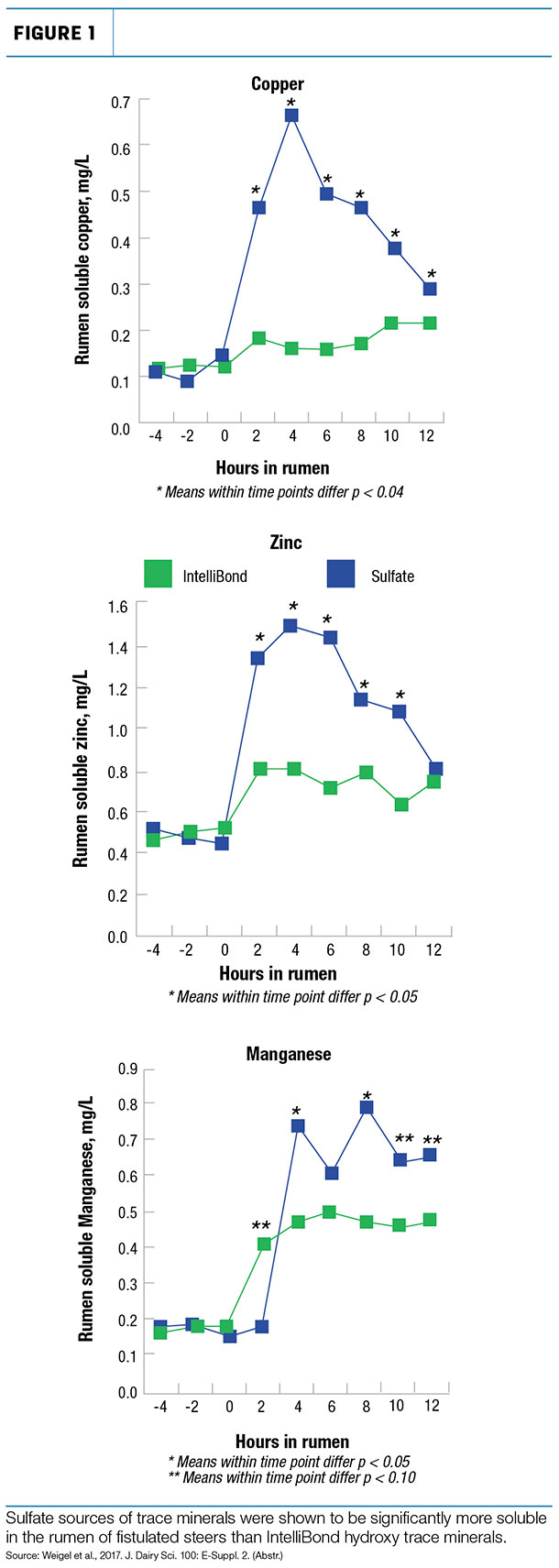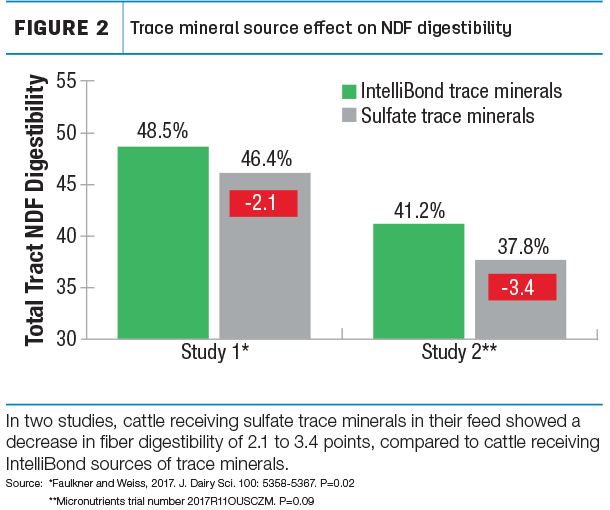Findings from studies conducted by leading research universities and pioneers in trace mineral nutrition suggest sulfate trace minerals may actually cause more harm than good when it comes to animal performance and producer economics.
For decades, sulfate trace minerals have been a “go-to” tool for supplementing the dairy cow diet with important nutrients such as copper, zinc and manganese. However, as scientists learn more about the characteristics of sulfate trace minerals, how they interact with other ingredients in animal feed and how they affect rumen function, studies suggest the consequences associated with sulfate trace minerals may outweigh the benefits.
The evolution of trace minerals in the dairy ration
Before addressing the concerns, it’s helpful to understand how sulfate trace minerals became so widely used in the dairy ration. Nutritionists have long known that supplementing cows’ diets with small amounts of copper, zinc and manganese is a vital part of supporting functions such as immunity, fertility and metabolism.
Beginning in the 1950s, sulfate trace minerals became the primary choice of trace mineral supplementation as dairymen shifted away from the use of oxide mineral sources. Organic trace minerals were introduced in the 1970s. While many organic trace mineral sources delivered good results, their high cost meant producers typically included them as a fraction of trace mineral supplementation (e.g., 20 percent organics and 80 percent sulfate trace minerals). However, beginning in the 2000s, a new alternative for trace mineral supplementation became available with the introduction of hydroxy trace minerals. Hydroxy trace minerals offer equal or better performance compared to organics at significantly less cost.
To better understand the factors explaining the performance difference between hydroxy trace minerals and sulfate trace minerals, research was conducted to evaluate and compare how different sources of trace minerals work inside the cow’s gastrointestinal tract. The findings pointed to three reasons why dairymen may want to rethink the use of sulfate trace minerals in their rations.
Reason 1: Sulfate trace minerals have high reactivity in the rumen
As scientists studied sulfate sources of trace minerals and compared them to hydroxy trace minerals, the structure of the minerals was an important area of focus. Sulfate trace minerals are comprised of weak ionic bonds that are significantly more soluble in water than hydroxy trace minerals. A trial was conducted by scientists at a research university that showed sulfate trace minerals were significantly more soluble in the rumen than hydroxy trace minerals (Figure 1). The weak bonds and more soluble nature of sulfate trace minerals cause the minerals to disassociate too early.

Reason 2: Sulfate trace minerals may harm beneficial rumen microbes
Inside the rumen, the loose ionic bonds in sulfate trace minerals can cause the mineral to disassociate. Consequently, these free metal ions can potentially harm the beneficial bacteria that digest fiber. In contrast, hydroxy trace minerals are comprised of a crystalline structure and covalent bonds that make them less soluble and less susceptible to disassociation in the rumen, thus making it harder for free metal to release in the rumen environment.
“Good” microbes in the rumen play a big role in promoting fiber digestibility and supporting the production of important fatty acids used by the cow for energy and milk production. As these microbes multiply and travel throughout the digestive tract, they become a high-quality source of protein for the cow, providing about half the total dietary protein needed. Thus, a feed ingredient that interferes with microbial activity in the rumen – where 90 percent of digestion takes place –can interfere with important digestive functions.
Sulfate trace minerals have long been used in footbaths for their efficacy in killing microbes. Unfortunately, the same properties that make sulfate trace minerals effective in footbaths can potentially harm rumen microbial populations. Supplemental copper, zinc and manganese are not needed for rumen microbes when practical diets are fed, as the basal diet provides adequate nutrition to support their dietary requirement.
Reason 3: Sulfate trace minerals have been shown to reduce NDF digestibility
Understanding that microbial activity in the rumen helps promote neutral detergent fiber digestibility (NDFD) and supports the production of important fatty acids, animal scientists from research universities compared how sulfate trace minerals and hydroxy trace minerals affected NDFD in the rumen.
The research found a decrease in NDFD of 2.1 to 3.4 points when sulfate trace minerals were fed compared to hydroxy trace minerals (Figure 2). As literature and data suggest a one-point increase in NDFD translates to a half-pound increase in production of fat-corrected milk, study data suggests that hydroxy trace minerals compared to sulfate trace minerals may help cows increase milk production, translating into improved profitability for dairymen.

Planning a path forward
There are three paths forward when removing sulfate trace minerals from the dairy ration. One option is to feed all organic trace minerals; however, the benefits may be offset by the additional cost. A second option is to replace sulfate trace minerals with hydroxy trace minerals. And a final option is to replace sulfate trace minerals with a ratio of organic and hydroxy trace minerals. A conversation with a nutritionist can help dairymen assess how sulfate trace minerals may be affecting their herds. Here are some questions to ask:
- Does my ration include sulfate sources of trace minerals?
- Based on new information, should I continue feeding sulfate trace minerals?
- What are the benefits of improved NDFD if we remove sulfate trace minerals from our ration?
As dairymen consider changes to enhance their herds’ nutrition in 2019 without sacrificing economics, a conversation with a dairy nutritionist is a good place to start. ![]()
References omitted but are available upon request. Click here to email an editor.

-
Dr. Scott Fry
- Director of Technical Sales Support
- Micronutrients






